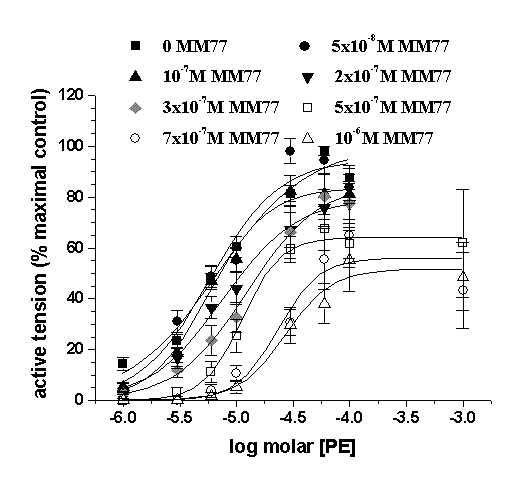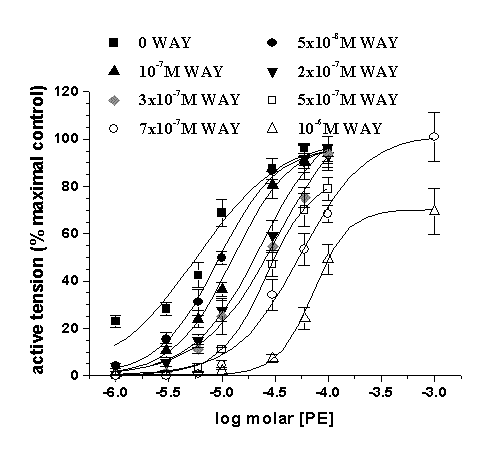| pA2 online © Copyright 2004 The British Pharmacological Society |
056P
University of Bath Summer Meeting July 2004 |
|
A comparison of the effects of the putative 5HT1A antagonist MM-77 with WAY-100635 on the mouse isolated vasa deferentia M.J. Arkle, S. Arkle & I.S. Ebenezer. Neuropharmacology Research Group, School of Pharmacy and Biomedical Sciences, University of Portsmouth, Portsmouth, PO1 2DT, U.K |
|
1-(2-methoxyphenyl)-4-(4-succinimidobutyl) piperazine (MM-77) is a putative 5-HT1A antagonist with apparent specificity for postsynaptic 5HT1A receptors (Mokrosz et al., 1994). However, we have reported that MM-77 displays some characteristics of a 5-HT1A agonist and an adrenoceptor antagonist (Arkle et al., 2004). The mouse vas deferens has a high density of adrenergic receptors (Kitchen, 1984) and our preliminary experiments showed that MM-77 produces concentration-dependent inhibition of contractile responses to submaximal electrical field stimulation, indicative of adrenergic inhibition. To further characterise this effect, we compared the effects of MM-77 and the selective 5-HT1A antagonist WAY100635 (Fletcher et al., 1996) on phenylephrine (PE)-stimulated contractions of mouse isolated vas deferens.
Adult male CFLP mice (b. wt. ~50g) were killed by exposure to CO2 and cervical dislocation. Vasa deferentia were mounted in 15 ml organ baths in Krebs Ringer for isometric recording (Kitchen, 1984), incubated with 10-7-10-6M MM-77 or WAY-100635 and then sequentially exposed to 10-6–10-3M PE for 30s in a 3 min time cycle Schild plots were constructed from these data with dose ratios calculated at 25% of tissue maximal response (Emax).
MM-77 produced a rightward shift of concentration-responses curves to PE with a progressive decrease in Emax (fig.1). Schild plots of these data were linear with a mean intercept of -6.8 ± 0.1 and slope of 1.42 ± 0.2, consistent with non-competitive antagonism at ![]() 1 -adrenoceptors. By contrast, while WAY-100635 also caused a rightward shift of the PE concentration-response curves, there was no loss of Emax except at the 1 μM concentration (fig. 2). Schild plots of these data were linear with a mean intercept of -7.1±0.1 and slope of 1.0±0.1, consistent with competitive
1 -adrenoceptors. By contrast, while WAY-100635 also caused a rightward shift of the PE concentration-response curves, there was no loss of Emax except at the 1 μM concentration (fig. 2). Schild plots of these data were linear with a mean intercept of -7.1±0.1 and slope of 1.0±0.1, consistent with competitive ![]() 1-adrenoceptor antagonism.
1-adrenoceptor antagonism.
WAY-100635 has a 10 fold greater potency than MM-77 in vivo and this may explain the overt adrenergic antagonistic effects that we reported with MM-77 in behavioural studies (Arkle et al., 2004). Nevertheless, the action of these drugs at ![]() -adrenoceptors may confound interpretation of selective 5-HT1A receptor effects in behavioural experiments.
-adrenoceptors may confound interpretation of selective 5-HT1A receptor effects in behavioural experiments.
Fig.1. Effects of MM-77 on PE-stimulated contractile responses in vas deferens, n=7.

Fig.2. Effects of WAY-100635 on PE-stimulated contractile responses in vas deferens, n=6.

Arkle, M.J. et al., (2004) Proc. Br. J. Pharmacol., in press
Fletcher, A. et al. (1996). Behav. Brain Res., 73, 337 – 353
Kitchen, I. (1984) Textbook of In Vitro Practical Pharmacology, Blackwell, Oxford
Mokrosz, J.J. et al. (1994) J. Med. Chem., 37, 2754 – 2760
Merali et al., 1999 Neuropeptides 33, 376-386